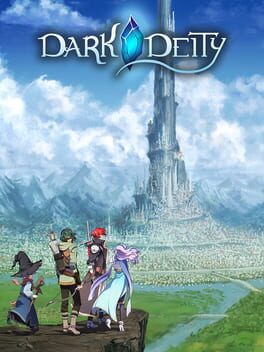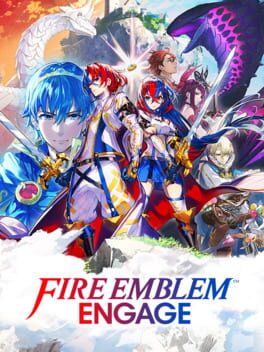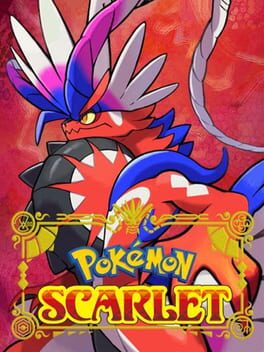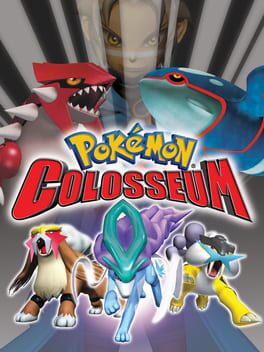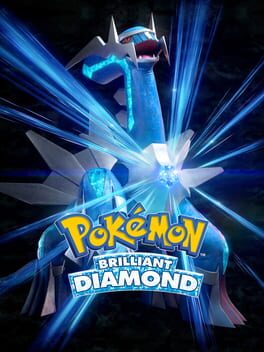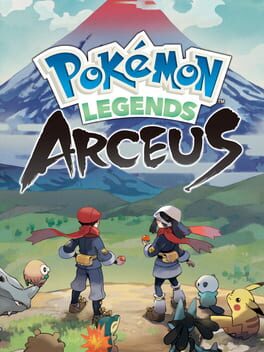JadeMonument
2021
A genuinely very great Fire Emblem-inspired game that specifically carries the vibes of the GBA era in its excellent and lively sprites, which are just as fun to watch in motion after putting in 70 hours as they are in the first ten. The game also has an excellent variety of chapter objectives.
Unfortunately, Dark Deity also suffers, even after numerous patches, from major issues, such as units sometimes being in two tiles at the same time, visually appearing to be in one tile when they are actually in another tile that they are not visible in, and some funky issues with the battle forecast in which certain classes (the Crusader in particular always seems to deal less damage in a given hit than they should). The story itself is serviceable on the whole, having its occasional moments, while the writing of the individual characters (especially in their "Supports", or rather their Bonds as the game calls them) is pretty good.
The class and skill system - where each character promotes into one of 4 classes based on their base class at level 10, each one having their own set of 2 class skills, and can then pick from another set of 4 classes (again, based on the original base class) with their own sets of 2 class skills - is genuinely very fun. Mixing and matching these with each character's personal skills and the Eternal Aspects (further skills, of which only one can be equipped at a time for each character) creates a fun and interesting character building system, without being too overwhelming. There are times where certain skills will display an old, outdated effect description on one screen despite having been changed later on in patches, which can be frustrating in causing misunderstandings about how a unit might work.
Overall though, the game is very good for what it is, despite its foibles, and I would heartily recommend it to anyone who enjoys the gameplay of Fire Emblem and especially the battle sprites of the GBA era games.
Unfortunately, Dark Deity also suffers, even after numerous patches, from major issues, such as units sometimes being in two tiles at the same time, visually appearing to be in one tile when they are actually in another tile that they are not visible in, and some funky issues with the battle forecast in which certain classes (the Crusader in particular always seems to deal less damage in a given hit than they should). The story itself is serviceable on the whole, having its occasional moments, while the writing of the individual characters (especially in their "Supports", or rather their Bonds as the game calls them) is pretty good.
The class and skill system - where each character promotes into one of 4 classes based on their base class at level 10, each one having their own set of 2 class skills, and can then pick from another set of 4 classes (again, based on the original base class) with their own sets of 2 class skills - is genuinely very fun. Mixing and matching these with each character's personal skills and the Eternal Aspects (further skills, of which only one can be equipped at a time for each character) creates a fun and interesting character building system, without being too overwhelming. There are times where certain skills will display an old, outdated effect description on one screen despite having been changed later on in patches, which can be frustrating in causing misunderstandings about how a unit might work.
Overall though, the game is very good for what it is, despite its foibles, and I would heartily recommend it to anyone who enjoys the gameplay of Fire Emblem and especially the battle sprites of the GBA era games.
2023
An entirely competent Fire Emblem game. While it's presentation and straightforward plot may be off-putting to those who enjoyed what Three Houses did, and those who disliked the monastery will find that even a pared-down version of it in this game's home base is still a load of meaningless busywork chores that bloat the game's run time, Engage is a fun enough Fire Emblem game.
Engage does shine in its mechanical ideas, even if it failed to impress people with its writing or hodgepodge of wild character designs. Granting units specific benefits based on their general classification helps to balance the high-mobility cavalry and flying classes against the rest as they trade their mobility for the benefits other classes provide - Covert classes (such as Archers and Thieves) grant additional Avoid when standing on tiles that already give an Avoid boost, while Backup classes (such as Warrior and Swordmaster) will provide additional chip damage that can quickly stack up if an ally initiates combat within the unit's current attack range with their equipped weapon.
The Break mechanic, this game's version of the weapon triangle in which a unit with weapon triangle superiority over the opponent will disarm that opponent when they initiate combat against them, stands as one of the weaker mechanics introduced in the game, however. I cannot speak to how it feels while playing on the game's highest difficulty, but in general, the mechanic was quickly forgotten after the game's opening maps in my experience, and the times my units broke their opponents became an "oh neat" moment, while the enemies breaking my own units was a headache but generally manageable with even a small amount of planning around the potential.
The titular Engage mechanic, on the other hand, is... Engaging! Having a semi-limited resource that gives your units new capabilities for a few turns is interesting, and I think a version of it could make for an interesting mechanic in future entries if given some additional polish and thought. As I've been watching a playthrough of the Tellius games recently, it occurs to me that this is actually somewhat similar to the laguz gauge of those games' "beast" units, so it isn't exactly as if the concept is unheard of in the franchise prior. Perhaps we could see another spin on it in the future?
Ultimately, Engage is as I said at the top - an entirely competent Fire Emblem game. While it has some neat ideas and is a fun enough game, it doesn't do much to really stand out from the rest. If you enjoy Fire Emblem games enough to be tempted by it, I'd say to give it a shot. While it won't blow you away by any means, you'll have a decent time on the ride through to the credits.
Engage does shine in its mechanical ideas, even if it failed to impress people with its writing or hodgepodge of wild character designs. Granting units specific benefits based on their general classification helps to balance the high-mobility cavalry and flying classes against the rest as they trade their mobility for the benefits other classes provide - Covert classes (such as Archers and Thieves) grant additional Avoid when standing on tiles that already give an Avoid boost, while Backup classes (such as Warrior and Swordmaster) will provide additional chip damage that can quickly stack up if an ally initiates combat within the unit's current attack range with their equipped weapon.
The Break mechanic, this game's version of the weapon triangle in which a unit with weapon triangle superiority over the opponent will disarm that opponent when they initiate combat against them, stands as one of the weaker mechanics introduced in the game, however. I cannot speak to how it feels while playing on the game's highest difficulty, but in general, the mechanic was quickly forgotten after the game's opening maps in my experience, and the times my units broke their opponents became an "oh neat" moment, while the enemies breaking my own units was a headache but generally manageable with even a small amount of planning around the potential.
The titular Engage mechanic, on the other hand, is... Engaging! Having a semi-limited resource that gives your units new capabilities for a few turns is interesting, and I think a version of it could make for an interesting mechanic in future entries if given some additional polish and thought. As I've been watching a playthrough of the Tellius games recently, it occurs to me that this is actually somewhat similar to the laguz gauge of those games' "beast" units, so it isn't exactly as if the concept is unheard of in the franchise prior. Perhaps we could see another spin on it in the future?
Ultimately, Engage is as I said at the top - an entirely competent Fire Emblem game. While it has some neat ideas and is a fun enough game, it doesn't do much to really stand out from the rest. If you enjoy Fire Emblem games enough to be tempted by it, I'd say to give it a shot. While it won't blow you away by any means, you'll have a decent time on the ride through to the credits.
2022
Despite being an often buggy, lagging mess of a game, Pokemon Scarlet and Violet are perhaps some of the most fun I've had in a mainline Pokemon game without the need for further modifier. Running around in the world, getting lost and sidetracked in your trekking by the idea of what Pokemon you might find just past the next landmark...
While there are definite rough edges, if the Pokemon franchise takes what worked from Pokemon Legends Arceus and now Pokemon Scarlet and Violet forward, I honestly believe that there's cause to think optimistically about what the future has in store for the mainline franchise.
While there are definite rough edges, if the Pokemon franchise takes what worked from Pokemon Legends Arceus and now Pokemon Scarlet and Violet forward, I honestly believe that there's cause to think optimistically about what the future has in store for the mainline franchise.
2003
This review contains spoilers
Colosseum is one of those games I have a lot of nostalgia for - I got properly introduced to Pokemon as a franchise with the third generation, and as I had a GameCube, Colosseum was one of those games that really got me hooked. I decided to replay this game to scratch the Pokemon itch ahead of Scarlet and Violet's release, and while I think in a lot of ways this game holds up, there are some notable flaws going back to it today.
The entire game being built around double battles is a cool mechanic that makes me wish another Pokemon game would revolve around an alternate battling style than the ever-present single battles in the main franchise, and is one of the high points of the game as it encourages using strategies you otherwise wouldn't - such as setting up weather to improve Thunder's accuracy, or running Jumpluff despite the fact that third generation Jumpluff learns absolutely no real damaging moves for some reason and entirely for its Sleep Powder and high Speed letting you take half of your opponent's on-field Pokemon out of the picture.
The music is fantastic, and the setting of Orre is - despite being rather barren and consisting of only a handful of locations - a very interesting one, especially in the context of other Pokemon regions at the time of Colosseum's release.
Unfortunately, this is about where my list of positives ends. The core of Pokemon is great, but going back to Colosseum in the modern era leaves something to be desired. Taking off those rose-tinted glasses reminds you that those lively and fun animations for every single action a Pokemon takes are slow, resulting in a large amount of downtime between actual actions you can input during battles. The second-to-last dungeon in the game has no place to properly heal your Pokemon at the location at all, forcing you to backtrack to the start and either leave for another area where you can heal your Pokemon or spend time swapping your Pokemon around in the PC at the start of the dungeon, which is janky and feels at least a little unintended - and, of course, the dungeon has too many trainers and the double battle format means you will be taking damage and running out of PP for moves if you don't backtrack to heal regularly. Additionally, this second-to-last dungeon makes a fascinating decision to just completely remove the music in favor of a headache-inducing blaring siren for the last third of its length, which is a real shame in a game that has such amazing music.
The worst part of the experience, however, is absolutely the ending. Gameplay spoilers for the final sequence of Colosseum's plot follow: After navigating a dungeon made artificially longer by requiring you to watch short cutscenes between each small area of the dungeon, you are thrown into a 6-battle gauntlet. Your team is healed before battles 5 and 6, but you do not have an opportunity to save between battles. I know for a fact that you can return to the 6th battle without needing to go through the entire gauntlet again if your entire team is knocked out, and I would imagine this is true of the 5th battle as well but cannot confirm it from experience. Now, this in and of itself would not necessarily be a problem, except there are some additional fun wrinkles. First, every single battle in that gauntlet features a Shadow Pokemon, which you are incentivized to catch of course. Second, there is a 15 level jump from the start of the gauntlet - where trainers have level ~45 Pokemon, which, if you have not been grinding, is about where the game up until this point has expected your Pokemon to be - to the end, with the final boss's entire team (sans their Shadow Pokemon) being level 60-61. Sadly, I had completely forgotten that this was the case until I was going into this final boss fight, resulting in a situation where my team was completely incapable of actually winning due to the sheer numerical difference between my team and the final boss's. This is a shame, because up until this point in the game, playing through normally will result in your team being appropriately leveled for the encounters you are going into; this sudden ramp in opponent strength is not foreshadowed by the game at all. The final dungeon itself features no place to potentially grind your Pokemon or purchase items either, so if you wish to do either, you are forced to completely, manually walk back out and make the trek all the way to the end once again if you wish to prepare yourself for the final boss appropriately if you get demolished with no hope of winning the way I did.
Ultimately though, my trip back through Pokemon Colosseum was an enjoyable time, even if I don't think the game has quite withstood the test of time as nicely as I might have wished. If you're going in blind (or at least mostly blind) the way I did, I would consider knocking half a point off of my rating just for how bad the level jump is at the very end of the game, but otherwise I feel comfortable giving this game a solid 3/5 rating.
The entire game being built around double battles is a cool mechanic that makes me wish another Pokemon game would revolve around an alternate battling style than the ever-present single battles in the main franchise, and is one of the high points of the game as it encourages using strategies you otherwise wouldn't - such as setting up weather to improve Thunder's accuracy, or running Jumpluff despite the fact that third generation Jumpluff learns absolutely no real damaging moves for some reason and entirely for its Sleep Powder and high Speed letting you take half of your opponent's on-field Pokemon out of the picture.
The music is fantastic, and the setting of Orre is - despite being rather barren and consisting of only a handful of locations - a very interesting one, especially in the context of other Pokemon regions at the time of Colosseum's release.
Unfortunately, this is about where my list of positives ends. The core of Pokemon is great, but going back to Colosseum in the modern era leaves something to be desired. Taking off those rose-tinted glasses reminds you that those lively and fun animations for every single action a Pokemon takes are slow, resulting in a large amount of downtime between actual actions you can input during battles. The second-to-last dungeon in the game has no place to properly heal your Pokemon at the location at all, forcing you to backtrack to the start and either leave for another area where you can heal your Pokemon or spend time swapping your Pokemon around in the PC at the start of the dungeon, which is janky and feels at least a little unintended - and, of course, the dungeon has too many trainers and the double battle format means you will be taking damage and running out of PP for moves if you don't backtrack to heal regularly. Additionally, this second-to-last dungeon makes a fascinating decision to just completely remove the music in favor of a headache-inducing blaring siren for the last third of its length, which is a real shame in a game that has such amazing music.
The worst part of the experience, however, is absolutely the ending. Gameplay spoilers for the final sequence of Colosseum's plot follow: After navigating a dungeon made artificially longer by requiring you to watch short cutscenes between each small area of the dungeon, you are thrown into a 6-battle gauntlet. Your team is healed before battles 5 and 6, but you do not have an opportunity to save between battles. I know for a fact that you can return to the 6th battle without needing to go through the entire gauntlet again if your entire team is knocked out, and I would imagine this is true of the 5th battle as well but cannot confirm it from experience. Now, this in and of itself would not necessarily be a problem, except there are some additional fun wrinkles. First, every single battle in that gauntlet features a Shadow Pokemon, which you are incentivized to catch of course. Second, there is a 15 level jump from the start of the gauntlet - where trainers have level ~45 Pokemon, which, if you have not been grinding, is about where the game up until this point has expected your Pokemon to be - to the end, with the final boss's entire team (sans their Shadow Pokemon) being level 60-61. Sadly, I had completely forgotten that this was the case until I was going into this final boss fight, resulting in a situation where my team was completely incapable of actually winning due to the sheer numerical difference between my team and the final boss's. This is a shame, because up until this point in the game, playing through normally will result in your team being appropriately leveled for the encounters you are going into; this sudden ramp in opponent strength is not foreshadowed by the game at all. The final dungeon itself features no place to potentially grind your Pokemon or purchase items either, so if you wish to do either, you are forced to completely, manually walk back out and make the trek all the way to the end once again if you wish to prepare yourself for the final boss appropriately if you get demolished with no hope of winning the way I did.
Ultimately though, my trip back through Pokemon Colosseum was an enjoyable time, even if I don't think the game has quite withstood the test of time as nicely as I might have wished. If you're going in blind (or at least mostly blind) the way I did, I would consider knocking half a point off of my rating just for how bad the level jump is at the very end of the game, but otherwise I feel comfortable giving this game a solid 3/5 rating.
A faithful remake of a very solid entry in the mainline Pokemon games. Unfortunately, there's not much else to say - despite the upgraded Underground allowing for a greater variety of Pokemon available (which even fixes the issue Sinnoh has with a lack of Fire types), there's just not enough going on here to justify it's own existence when a much better Sinnoh experience exists in the form of Platinum. If you wanted to experience Diamond and Pearl because you have not prior, and you want to have the original Sinnoh experience before playing Platinum, then I heartily recommend Brilliant Diamond and Shining Pearl. Otherwise, you're better off just playing Platinum.
Despite it's graphical and technical flaws, Legends Arceus may genuinely be one of the most fun Pokemon game to exist. It is most certainly the single most fun game in the main franchise, at the very least.
Edit, post-Pokemon SV's release: While I stand by that this is one of the most fun and innovative mainline releases by virtue of actually shaking up the series' formula for the better, it's hard to say that it's the most fun game in the mainline franchise as well. I feel like it almost deviates too much from the formula to really be considered such, at least. At any rate, it is still an incredibly fun time, and I do hope we can see other Pokemon games made in this style that can offer additional polish and new ideas built on the foundation this game laid.
Edit, post-Pokemon SV's release: While I stand by that this is one of the most fun and innovative mainline releases by virtue of actually shaking up the series' formula for the better, it's hard to say that it's the most fun game in the mainline franchise as well. I feel like it almost deviates too much from the formula to really be considered such, at least. At any rate, it is still an incredibly fun time, and I do hope we can see other Pokemon games made in this style that can offer additional polish and new ideas built on the foundation this game laid.
